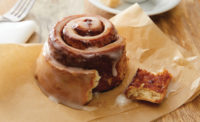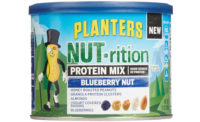Whether center-of-store or along the perimeter in the fresh bakery section, sweet goods are on the rise. According to the 2017 “What’s in Store” report from the International Dairy Deli Bakery Association, in-store bakeries have experienced much success over the past five years, soaring 51 percent in total annual sales to reach $15.7 billion dollars, enjoying a 7.9 percent increase in the past year alone. While these departments certainly contain staples like bread, it’s sweet goods that arguably account for its success, with Nielsen estimating that about 50 percent of the offerings are desserts.
In the center aisle, sweet goods like pastries, cinnamon rolls, doughnuts and muffins are also experiencing growth.
According to data from IRI, Chicago, category dollar sales of pastry and doughnuts (a category that also includes muffins) grew 4.1 percent for the 52 weeks ending March 19, 2017 to reach $5.0 billion. The pastry/Danish/coffee cakes segment grew by 3.5 percent to $2.0 billion, doughnuts were up 2.7 percent to $2.0 billion and muffin sales were up 8.3 percent to $976.6 million.
Private label leads every segment in the category, with notable gains in pastry/Danish/coffee cakes (up 13.2 percent to $389.9 million) and muffins (up 13.6 percent to $313.3 million). Other standouts include Hostess Brands, up 27.3 percent in pastry/Danish/coffee cakes to $104.6 million, per IRI.
Multiple companies saw growth in doughnuts, with Hostess Brands just behind private label with 9.4 percent growth to $365.5 million; United States Bakery up 23.1 percent to $21.6 million; Bon Appetit up 25.2 percent to $16.2 million; and Clyde’s Delicious Doughnuts up 31.0 percent to $13.7 million.
In the growing muffin segment, Grupo Bimbo follows private label with 11.2 percent dollar sales growth to $298.8 million. ARYZTA also saw a strong gain of 10.5 percent to $48.8 million.
In the bakery snacks category, which includes packaged sweet goods like honey buns and cinnamon rolls, dollar sales grew by 3.9 percent to $3.3 billion. McKee Foods leads the category, up 3.2 percent to $824.8 million. Private label sits in the No. 2 slot for the category, up 8.1 percent to $690.1 million. Hostess Brands also saw notable growth, up 10.1 percent to $652.9 million.
Indulgence factor
“Oftentimes, sweet goods are considered to be an impulse or indulgent purchase,” says Lance Aasness, vice president, Hinds-Bock, Bothell, WA. “Even when the economy is running low, consumers will find a way to buy that glazed doughnut, blueberry muffin, or soft chewy gourmet cookie—and sometimes, even more so.”
One of the ways consumers are indulging in these treats is by limiting their intake with a miniature offering. “Sales for smaller specialty products, such as filled mini ring doughnuts, are growing,” says Patricia Kennedy, president, WP Bakery Group USA, Shelton, CT. “This reduces any feeling of guilt involved with consuming sweet products, and it’s a convenient snack.” This option is appealing for all, she adds, as the customer is prepared to pay more for mini treats that might not cost more for bakers to produce with the right equipment.
Previously, notes Rick Hoskins, president, Colborne Foodbotics, Lake Forest, IL, bite-sized filled and topped products were difficult to pack using automated depanning and packaging processes. “Today, through new end effector technology, we are able to provide depanning and packaging process automation. In addition, these end effectors offer automatic tool change for customers who run different varieties and sizes, so they can have essentially push-button changeover in minutes.”
This trend extends to foodservice. Jill Thomas, vice president of marketing, Cinnabon, Atlanta, says smaller serving sizes allow for more portability and convenience while lessening the guilt factor associated with larger portion sizes. To that end, Cinnabon offers snack-sized BonBites, CinnaSweeties and MiniBons (that being said, classic rolls, she points out, are still their top-sellers…).
Yet another way consumers seek to make their indulgences “worth it” is by choosing products with premium ingredients, says Jessica Vogel, marketing communications manager, Kerry, Beloit, WI. “Today’s consumers crave premium products, and their preferences are shifting toward more indulgent baked goods … if they are going to indulge, they want the best quality possible.” Ingredients at the forefront of sweet goods include Belgian dark chocolate over conventional chocolate and Montmorency cherries, which both convey exclusivity with points of origin, she notes.
Select types of fruit can effectively convey premium positioning. According to consumer research from the U.S. Highbush Blueberry Council, in-person interviews showed 88.8 percent of consumers are willing to pay $0.50 or more for products containing real blueberries.
Flavors and ingredients
According to Aasness, nontraditional flavors that have transformed other snacking segments are making their way to sweet goods. He cites combinations like candied ginger and orange-infused muffins or salted-caramel and salted-chocolate pastries. “Consumers are always looking for different and exciting flavors—but not too different.”
Tea and coffee flavors are on the radar at Kerry, as bakeries draw inspiration from the coffeehouse. Matcha, in particular, is one flavor trend on the rise, says John Lochinski, market research and consumer insights, because there has been a steady growth in consumer awareness of this ingredient’s functional benefits, in addition to its flavor profile. “This figurative ‘sweet spot’ allows consumers to both indulge in a baked good while also feeling good about the halo of benefits, including immune health, antioxidants, detoxification properties and increased energy.” Kerry offers a natural matcha flavor and cold brew coffee extract that can be used in a variety of sweet goods.
The Scone Shop is tapping into trends, including savory, with varieties like Cranberry Orange, Spinach Feta and Bacon Cheddar. These scones, says Fielding Williams, founder and owner, are appropriate and versatile enough for breakfast, snacks, dinner or appetizers. “Fresh fruit, vegetables and protein (bacon) give the consumer delicious flavors, while still providing nutrients needed to power through the day,” she says. Plus, because they’re savory, they tap into demands for better-for-you, low-sugar products.
Of course, “better-for-you” means different things to different consumers—and is met with different formulation approaches.
“Even in indulgent categories like sweet baked treats, consumers are looking for shorter ingredient statements with names they recognize,” says Bill Gilbert, Certified Master Baker and principal food technologist, Cargill, Minneapolis. “We’re also seeing more bakeries request organic, non-GMO and allergen-free ingredient options.”
Cargill has responded to this demand with its new deoiled canola lecithin, launched in December 2016, which is non-GMO, appropriate for organic products and does not have to be declared as a major food allergen. According to Gilbert, it can be used as a one-to-one replacement for soy and sunflower lecithin to provide emulsifying, dough conditioning, moisture retention, fat extension and aeration benefits. “It’s a prime example of a pantry-friendly ingredient bakers can highlight, not hide from.”
Gluten-free currents also continue, particularly with consumers who don’t have a gluten intolerance and arrive at the category with perceived health benefits in mind.
This is a challenge, says Aasness, as gluten-free can present equipment design and building hurdles. It’s important to food manufacturers to know that their equipment will let them quickly and accurately run products all day on several shifts, he says—and also that the equipment will be specific to their applications. Hinds-Bock, he adds, can design and build custom equipment for such manufacturers.
David Moline, sales and marketing manager, Moline Machinery, Duluth, MN, says flexibility is paramount in the face of shifting trends in the sweet goods category. “Bakers with equipment flexibility have the ability to deliver innovative products first to market,” he says, “which is critical.” To that end, Moline Machinery offers modular, portable dough formers that change easily and provide different cell structures, depending on product needs. Additionally, the company offers cutting and stamping stations that utilize fast-change tooling for “virtually unlimited product shapes,” he says.
One ingredient on the rise in light of gluten-free trends is almonds, especially for sweet baked goods. Almond flour, for example, is a “versatile and nutritious alternative to traditional flour and pairs perfectly with multiple ingredients, like dried fruits, which are popular in baked goods,” says Molly Spence, director of North America, Almond Board of California, Modesto. “All of the many almond forms also lend themselves perfectly to the current flavor trend drivers, including coconut, matcha and chocolate.” Almond ingredients also appeal to vegans; almond milk and almond butter are both dairy-free alternatives appropriate for sweet goods.
Going forward, these trends will only grow and evolve. Aasness predicts that grab-and-go miniature serving sizes will remain in demand, as consumers’ lives get busier and busier. And, in light of “added sugar” labeling regulations coming down the pike, the better-for-you trend may evolve to also include low-sugar and low-calorie options, even in sweet goods.
This might prove particularly true in a product area like muffins. “We developed a great-tasting cupcake prototype using chicory root fiber and sweetened with stevia and erythritol,” says Pam Stauffer, global marketing programs manager, Cargill. “This reduced-sugar treat contains 37 percent less sugar and 15 percent fewer calories than its full-sugar counterpart.” That’s an indulgence almost anyone can afford.









